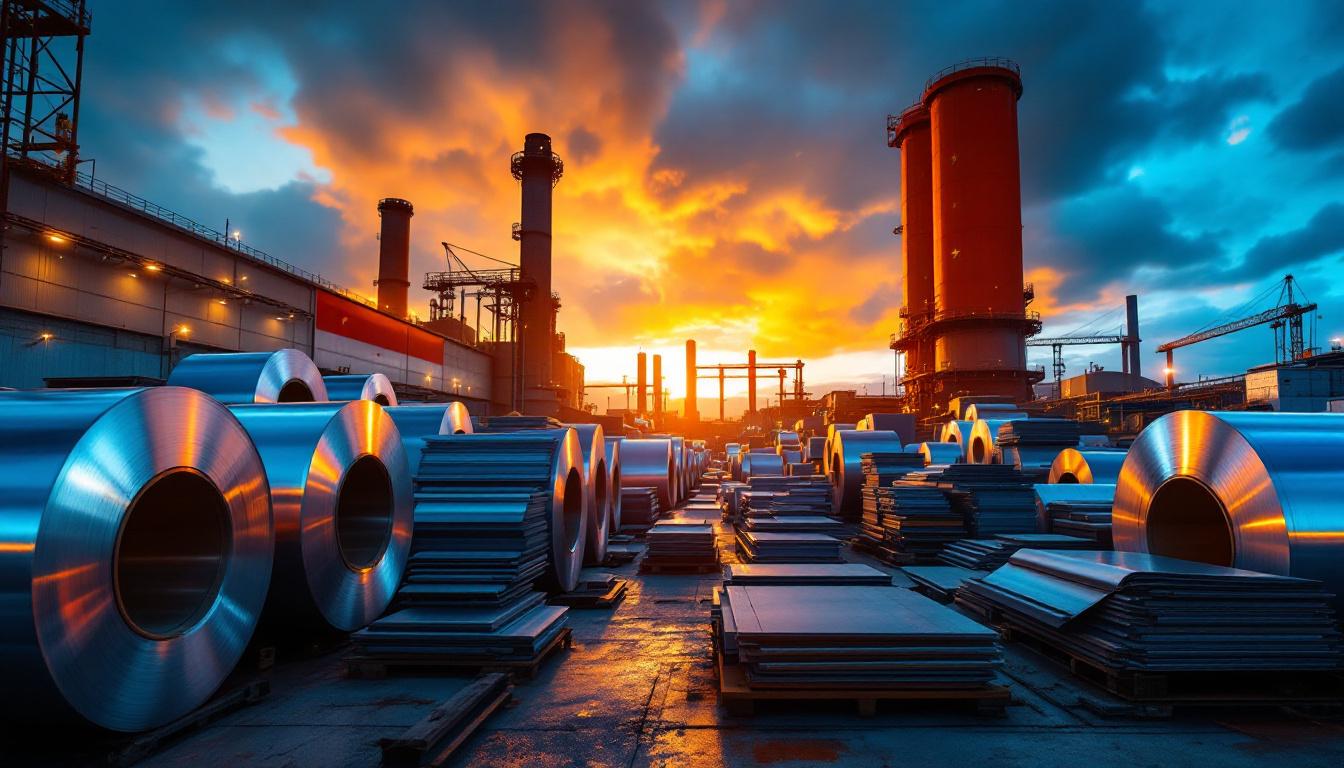What Is the DRC Cobalt Export Ban?
The Democratic Republic of Congo (DRC) recently announced a three-month extension to its cobalt export ban, continuing the restrictions initially implemented in February 2025. This pivotal policy prevents the export of unprocessed cobalt from the world's dominant producer, representing a significant shift in global supply chain dynamics.
The ban specifically targets raw cobalt exports while incentivizing domestic processing, requiring miners to convert cobalt into higher-value products like hydroxide or sulphate before export. This value-addition mechanism is projected to boost the local GDP contribution by an estimated 15-20%, according to the International Energy Agency's May 2025 Cobalt Supply Chain Review.
Strategic Importance of DRC Cobalt
The DRC's dominance in the cobalt market cannot be overstated, accounting for approximately 70% of global production according to the U.S. Geological Survey's 2025 Mineral Commodity Summaries. This market concentration gives the country significant leverage in dictating global supply conditions.
"The DRC's export ban aims to capture more value domestically by shifting from raw material exports to processed goods—a strategy aligned with resource nationalism trends seen across mineral-rich nations," explains Paul Lusty, Critical Minerals Specialist at the British Geological Survey.
The policy aligns with broader amendments to the DRC's 2022 Mining Code, which demands stricter local beneficiation, partly responding to pressures from regulations like the EU Critical Raw Materials Act. The implementation framework is being enforced through mining license revisions that mandate on-site refining capacity by 2027, according to the DRC Chamber of Mines.
This strategy follows a successful precedent: a similar 2020 copper export ban increased DRC refined copper output by 40% within 18 months, demonstrating the country's commitment to moving up the value chain rather than remaining merely a raw material supplier.
How Has the Market Reacted to the Ban Extension?
Immediate Price Impact
Following the June 21st announcement extending the ban, cobalt futures on the Zhonglianjin exchange experienced significant upward movement on the first trading day. According to London Metal Exchange data, cobalt prices jumped approximately 12% within 48 hours of the announcement, reflecting immediate market concerns about potential supply constraints.
This sharp price reaction demonstrates the market's sensitivity to policy changes in the DRC, even with existing stockpiles in the supply chain.
Supply-Side Response
The ban extension has triggered varied responses across the cobalt supply chain:
- Refined cobalt smelters: Continue fulfilling long-term contract obligations while limiting spot market quotations
- Traders: Adopted cautious wait-and-see positions with minimal price flexibility
- Intermediate product suppliers: Completely suspended price quotations while assessing market developments
Chinese refiners currently hold approximately 2-3 months of cobalt intermediate stocks according to CRU Group's Q2 2025 Cobalt Inventory Analysis, providing a temporary buffer against immediate shortages. However, this cushion could quickly erode if the ban extends beyond its current timeline.
Demand-Side Behavior
Despite increased inquiries from traders and downstream users following the policy announcement, actual transaction volumes remain notably limited. The SMM Cobalt Morning Meeting Summary reports that downstream buyers have shown reluctance to make purchases at elevated prices, preferring to observe market developments before committing to new orders.
"Short-term price volatility reflects market panic, but structural deficits could emerge if mid-stream inventories deplete faster than alternative sourcing scales," warns Caspar Rawles, Chief Data Officer at Benchmark Mineral Intelligence.
This cautious approach mirrors reactions to previous resource nationalism policies, such as Indonesia's 2021 nickel export ban, which caused LME nickel prices to surge 25% in one week according to the LME Monthly Bulletin.
What Are the Impacts Across Different Cobalt Products?
Refined Cobalt Market Dynamics
The refined cobalt market has experienced price increases coupled with reduced transaction activity. Most market participants have adopted a cautious stance, waiting for clearer market direction before engaging in significant trading activity.
Transaction volumes have dropped notably despite price gains, creating a situation where price discovery becomes increasingly difficult due to the limited number of market transactions serving as reference points.
Cobalt Intermediate Products
Suppliers of cobalt intermediate products have completely suspended price quotations following the ban extension. Mining companies and traders are holding inventory positions, while downstream smelters with sufficient stockpiles are depleting existing resources before considering new purchases.
This hesitation reflects a broader uncertainty about how long the DRC cobalt export ban will remain in place and how deeply it will affect global supply chains. Intermediate products face particularly sharp upside risk, as Yang Xiaohua, Cobalt Analyst at Antaike, notes: "Smelters can't absorb sustained 30%+ raw material cost hikes without passing them downstream."
Cobalt Chemical Compounds
The ban has triggered varying responses across different cobalt chemical compounds, each with unique supply chain characteristics:
Cobalt Sulphate
- Price trend: Halted previous decline and began rebounding
- Current price range: ¥49,000-50,000 per metric ton from limited quoting enterprises
- Supply situation: Most producers suspended quotations while observing market developments
- Demand factors: Limited improvement in orders from ternary cathode manufacturers
Cobalt sulphate enjoys partial insulation from immediate shortages via Chinese stockpiles and recycling streams, according to Roskill's Q1 2025 report on Cobalt Chemical Supply Chain Risks.
Cobalt Chloride
- Market status: Complete suspension of quotations with no transactions occurring
- Supply response: Smelters halted both quotations and shipments
- Price expectations: Preliminary estimates around ¥60,000 per metric ton
- Long-term outlook: Potential to exceed ¥70,000 per metric ton under optimistic scenarios
Cobalt chloride shows high sensitivity to the ban due to DRC dependency exceeding 80% of feedstock sources.
Cobalt Oxide (Co₃O₄)
- Current situation: Suspended quotations and shipments across the supply chain
- Price indications: Unofficial shipping price estimates around ¥210,000 per metric ton
- Key concern: Whether industry inventory can sustain operations until December 2025
Current Co₃O₄ prices (¥210,000/mt) exceed the 12-month average by 34% according to SMM Historical Cobalt Oxide Prices. The top three Chinese Co₃O₄ producers collectively hold approximately 4,500 metric tons of inventory, providing roughly 40 days of coverage based on current consumption rates.
How Is the Ban Affecting Battery Materials Production?
Impact on Ternary Cathode Precursors
Prices for 5-series, 6-series, and 8-series ternary cathode precursors have bottomed out and begun rebounding in response to the DRC policy announcement. While official quotations haven't shown significant fluctuations, market participants anticipate increased discount coefficients for cobalt sulphate in settlements between precursor manufacturers and downstream cathode material plants.
The cathode precursor market operates with sophisticated pricing mechanisms that incorporate both spot prices and long-term contract structures, making it somewhat less volatile than pure cobalt compounds. However, sustained raw material price increases will inevitably work their way through the supply chain.
Ternary Cathode Materials Market
The ternary cathode materials market has shown price rebounds despite continuing weakness in overall demand. The anticipated strong increase in cobalt sulphate prices is expected to offset the downward pressure from declining lithium chemical prices, supporting an overall rebound in ternary cathode material pricing.
This market segment faces a complex balancing act between:
- Rising cobalt input costs
- Softening lithium prices
- Ongoing pressure to reduce battery costs for EV manufacturers
- Competition from alternative chemistries like LFP
The resulting price dynamics show a smaller percentage increase than raw cobalt but still maintain an upward trend that could accelerate if the ban remains in place long-term.
LCO Cathode Production Challenges
Lithium cobalt oxide (LCO) cathode manufacturers have suspended quotations and shipments in response to market uncertainty. While battery-grade lithium carbonate prices continue declining, Co₃O₄ prices show strong upward sentiment due to the DRC policy.
Terminal battery cell manufacturers currently maintain sufficient inventory but face challenges in passing increased raw material costs to end customers. According to the SMM New Energy Industry Chain Database, typical LCO cathode producers operate with 25-30 days of cobalt oxide inventory, creating a time-limited buffer against immediate supply disruptions.
What Are the Long-Term Implications of the Ban?
Supply Chain Restructuring
The extended ban is accelerating efforts to diversify cobalt supply chains and develop alternative sources outside the DRC. Companies throughout the battery metals investment supply chain are reassessing inventory strategies and exploring options to reduce dependency on DRC-sourced materials.
Several strategic initiatives are gaining momentum:
- Geographic diversification: Increased investment in cobalt projects in Australia, Canada, and Indonesia
- Vertical integration: Battery and EV manufacturers securing direct stakes in mining operations
- Material innovation: Accelerated research into cobalt-thrifting technologies
- Recycling expansion: Enhanced focus on recovering cobalt from end-of-life batteries
These structural changes could permanently alter cobalt supply chains even if the DRC eventually relaxes its export restrictions.
Price Forecast and Market Sentiment
Market sentiment remains strongly bullish for cobalt intermediate products, with most enterprises expecting significant price increases. The specific magnitude of price changes will depend on:
- Actual transaction volumes in coming weeks
- Inventory levels across the supply chain
- Duration of the export restrictions
- Development of alternative supply sources
The consensus among analysts suggests that price volatility will remain elevated throughout Q3 2025, with potential stabilization only occurring if clear signals emerge about policy direction or if substantial new supply enters the market.
Strategic Responses from Industry Players
Battery manufacturers and automotive companies are likely to accelerate:
- Chemistry innovation: Research into cobalt-reduced or cobalt-free battery chemistries
- Recycling infrastructure: Development of capabilities to recover cobalt from end-of-life batteries
- Supply diversification: Exploration of alternative sourcing regions with cobalt deposits
- Vertical integration: Strategic investments across the value chain to secure supply
These strategic pivots require significant time and capital investment but may ultimately reduce the market's vulnerability to similar supply shocks in the future.
How Does the Ban Impact Different Battery Chemistries?
Effects on High-Nickel NMC Batteries
The continuous increase in cobalt sulphate prices is expected to benefit demand for medium-to-high nickel 6-series ternary cathode materials, which contain lower cobalt content than other formulations. This shift could accelerate the transition toward higher-nickel, lower-cobalt battery chemistries.
NMC 811 (containing 80% nickel, 10% manganese, and 10% cobalt) was already gaining market share before the ban, but the current price dynamics may accelerate this transition. Battery manufacturers must balance several factors:
- Reduced cobalt content lowers exposure to price volatility
- Higher nickel content introduces different supply security considerations
- Performance characteristics change with compositional adjustments
- Production processes require adaptation for different formulations
The ban may ultimately accelerate chemistry evolution that was already underway rather than triggering entirely new technical directions.
Impact on LFP vs. NMC Competition
Rising cobalt prices may further strengthen the competitive position of lithium iron phosphate (LFP) batteries, which contain no cobalt or nickel. This could accelerate the adoption of LFP chemistry in certain electric vehicle segments and energy storage applications where energy density requirements are less stringent.
LFP batteries have already made significant inroads in:
- Mass-market electric vehicles
- Commercial vehicles and buses
- Stationary energy storage systems
- Two- and three-wheeled electric vehicles
The widening cost differential between cobalt-containing and cobalt-free chemistries could expand LFP's market share in these applications while potentially opening new segments where the cost advantage outweighs energy density considerations.
Small Power Battery Market Challenges
The small power battery market, which often relies on cobalt-containing chemistries, is entering its seasonal downward phase. The combination of seasonal weakness and rising cobalt prices presents particular challenges for manufacturers in this segment.
Consumer electronics, power tools, and other small-format battery applications typically cannot easily switch chemistries due to form factor and performance requirements. These manufacturers face particularly difficult decisions about inventory management and pricing strategy during this period of supply uncertainty.
FAQs About the DRC Cobalt Export Ban
Why Did the DRC Implement the Cobalt Export Ban?
The DRC implemented the ban to develop domestic processing capabilities, capture more value from its natural resources, and reduce the export of raw materials without added value. This strategy aims to create more jobs within the country and increase the economic benefits derived from its mineral wealth.
Similar policies have been implemented by other resource-rich nations seeking to move up the value chain, including Indonesia (nickel) and Chile (lithium). The approach aligns with broader resource nationalism trends that seek to maximize domestic economic benefits from natural resource extraction.
How Long Will the DRC Cobalt Export Ban Last?
The current extension adds three months to the previous ban, with the possibility of further extensions depending on domestic processing capacity development and government policy objectives. Market participants are preparing for potential longer-term restrictions.
While officially temporary, similar resource nationalization policies in other countries have often evolved into permanent structural changes in market dynamics. The ultimate duration will likely depend on:
- Progress in developing domestic processing capacity
- Global market response and price dynamics
- Political considerations within the DRC
- International pressure and diplomatic engagement
Companies are increasingly planning for extended or permanent restrictions rather than temporary disruptions.
Will the Ban Lead to Permanent Changes in Battery Chemistry?
While the ban may accelerate research into cobalt-reduced formulations, complete elimination of cobalt from all battery applications remains challenging in the near term. The ban is more likely to accelerate existing trends toward diversification of battery chemistries based on specific application requirements.
Cobalt serves critical functions in battery chemistry, including:
- Structural stability during charge/discharge cycles
- Thermal performance optimization
- Cycle life enhancement
- Energy density improvements
These technical benefits mean that cobalt reduction efforts will continue incrementally rather than through immediate wholesale replacement. The most likely outcome is accelerated adoption of existing cobalt-thrifting approaches rather than revolutionary new chemistries.
How Are Chinese Refiners Responding to the Ban?
Chinese refiners, who process much of the world's cobalt, are reassessing inventory strategies and exploring alternative sourcing options. Some are considering investments in processing facilities within the DRC to comply with the country's mineral beneficiation opportunities and value-addition requirements.
Several specific strategies are emerging:
- Increased interest in recycling streams to supplement primary supply
- Exploration of cobalt assets in alternative jurisdictions
- Joint ventures with DRC mining companies to establish in-country processing
- Technological innovations to improve recovery rates from existing materials
These adaptations demonstrate the market's ability to respond to policy changes, though full adjustment will require significant time and investment. Furthermore, the critical minerals energy transition is driving companies to seek secure and sustainable sources of cobalt beyond the DRC, with some turning to Australia's emerging Cobalt Blue expansion projects as potential alternatives.
Ready to Spot the Next Major Mineral Discovery?
Stay ahead of the market with Discovery Alert's proprietary Discovery IQ model, which instantly notifies investors about significant ASX mineral discoveries and translates complex data into actionable insights. Explore how historic discoveries have generated substantial returns by visiting our dedicated discoveries page and begin your 30-day free trial today.




